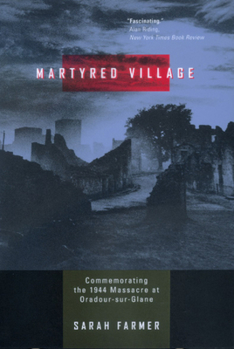Martyred Village: Commemorating the 1944 Massacre at Oradour-sur-Glane
Select Format
Select Condition 
Book Overview
Among German crimes of the Second World War, the Nazi massacre of 642 men, women, and children at Oradour-sur-Glane on June 10, 1944, is one of the most notorious. On that Saturday afternoon, four days after the Allied landings in Normandy, SS troops encircled the town in the rolling farm country of the Limousin. Soldiers marched the men to nearby barns, lined them up, and shot them. They then locked the women and children in the church, shot them, and set the building and the rest of the town on fire. Residents who had been away for the day returned to a blackened scene of horror, carnage, and devastation. In 1946 the French State expropriated and preserved the entire ruins of Oradour. The forty acres of crumbling houses, farms and shops became France's village martyr , set up as a monument to French suffering under the German occupation. Today, the village is a tourist destination, complete with maps and guidebooks. In this first full-scale study of the destruction of Oradour and its remembrance over the half century since the war, Sarah Farmer investigates the prominence of the massacre in French understanding of the national experience under German domination. Through interviews with survivors and village officials, as well as extensive archival research, she pieces together a fascinating history of both a shattering event and its memorial afterlife. Complemented by haunting photographs of the site, Farmer's eloquent dissection of France's national memory addresses the personal and private ways in which, through remembrance, people try to come to terms with enormous loss. Martyred Village will have implications for the study of the history and sociology of memory, testimonies about remembrances of war and the Holocaust, and postmodern concerns with the presentation of the past.
Format:Paperback
Language:English
ISBN:0520224833
ISBN13:9780520224834
Release Date:June 2000
Publisher:University of California Press
Length:317 Pages
Weight:0.86 lbs.
Dimensions:0.9" x 5.5" x 8.2"
Customer Reviews
2 ratings
interesting and dramatic
Published by Thriftbooks.com User , 23 years ago
sarah farmer has brought about the first difinitive book based on the martyred village. instead on focusing on the rather well known facts of the horrific massmacre, she gives great insight and back ground to the events leading up and following the massacre. as well as giving a personal insight to it, using her own photography, she gives a great narrative and all round factually based book which gives alot of hard to get material. for those who have visited the site or simply an enthusiast, you need not look further than this compelling, easy to read book.
Excellent presentation of history in rural Limousin, France.
Published by Thriftbooks.com User , 25 years ago
Sarah Farmer deserves high praise for the clear narration and helpful explanations throughout "Martyred Village." Other historians ought emulate her writing. She first describes the slaughter of 10 June 1944, SS troops killing the civilians of Oradour. She then places it in the context of 20th century France. Only nine months after the massacre, Charles de Gaulle solemnly visits the ruins. Quickly, Oradour becomes a site of pilgrimage. Disruption comes in 1953, when twenty-one soldiers of the SS are brought to trial in Bordeaux. Fourteen are Frenchmen from Alsace, thirteen conscripted by the Germans. Upon their conviction in court, the Alsatians were freed by amnesty granted by the National Assembly, yielding to protests from Strasbourg. The author's account continues to 1997. I appreciate the author's use of French and German names, ranks, and expressions. She clarifies the roles of the political parties. She treats well the topics of mourning, respect, memory, pilgrimage, and religion. As someone interested in electric transit, I hope someday to learn more of the rural tram from Limoges through Oradour, whatever its corporate name.






